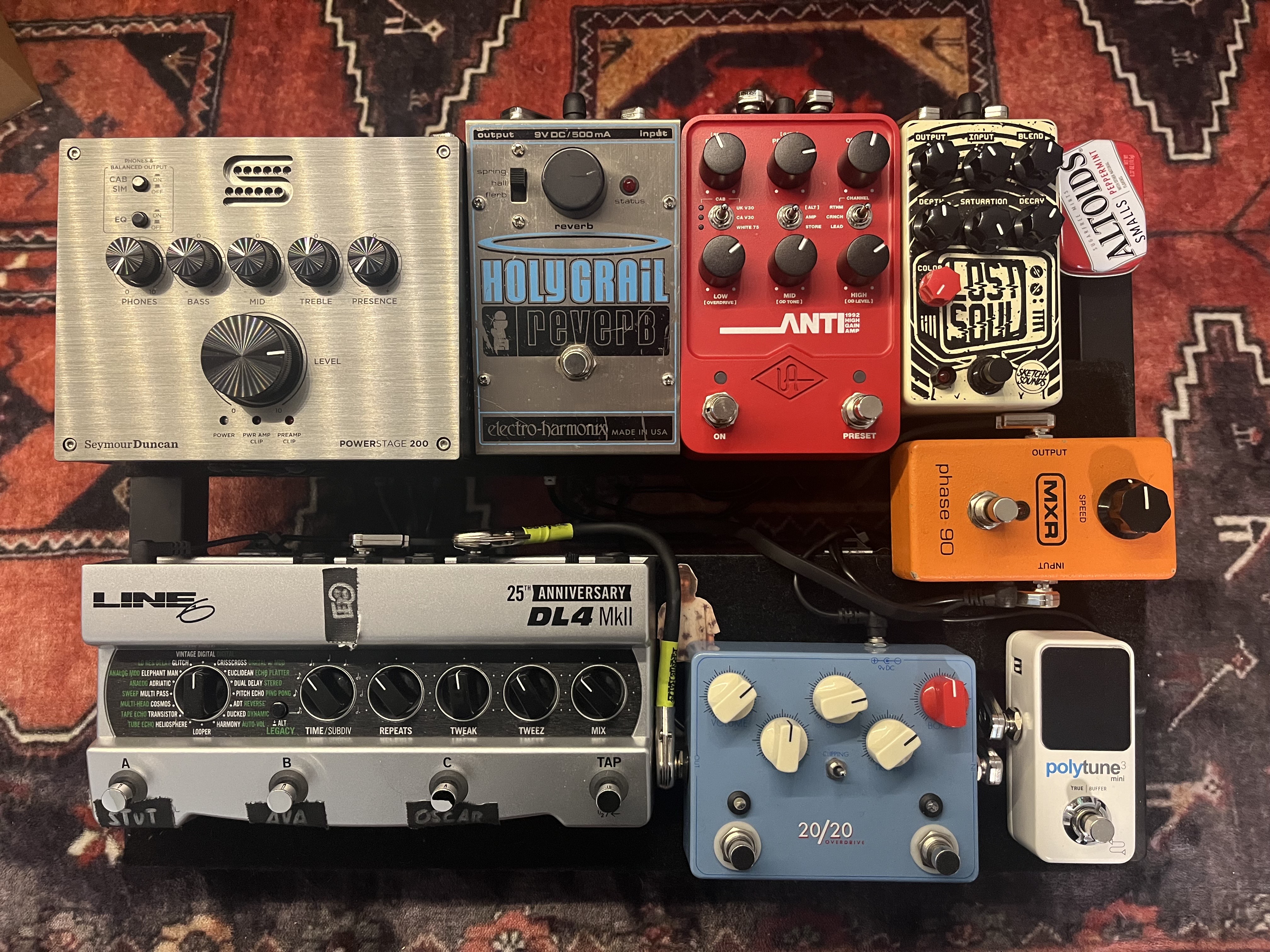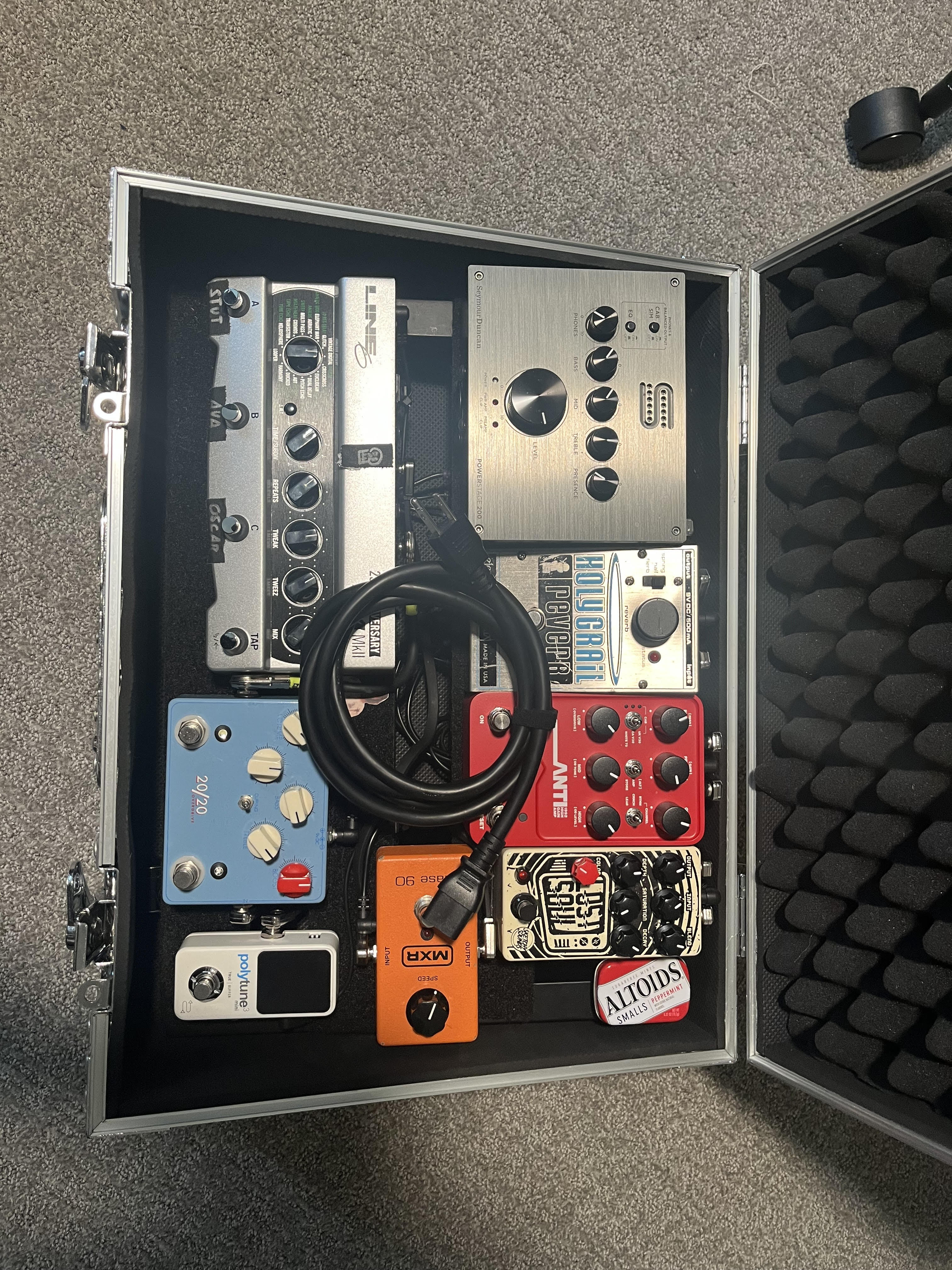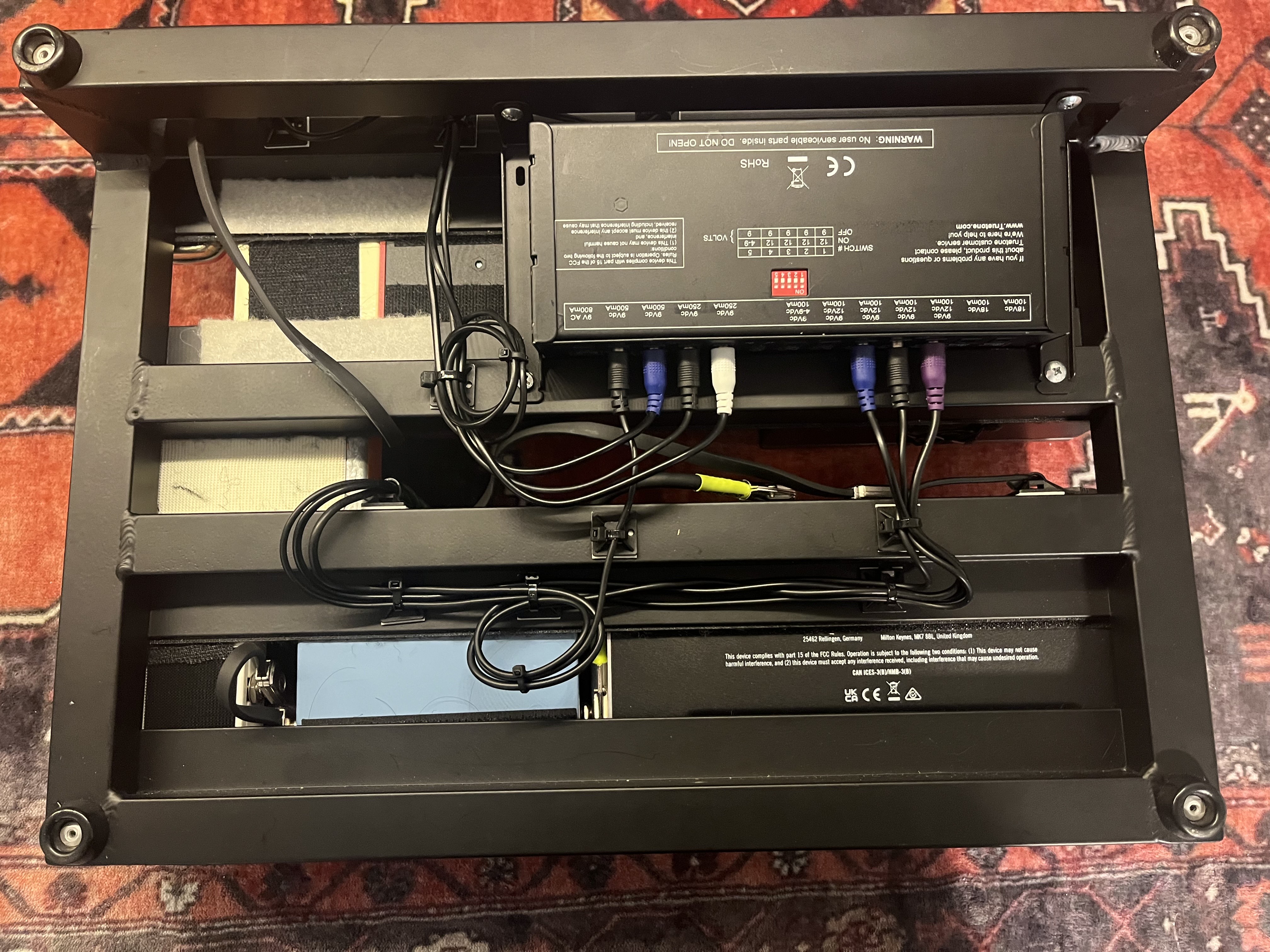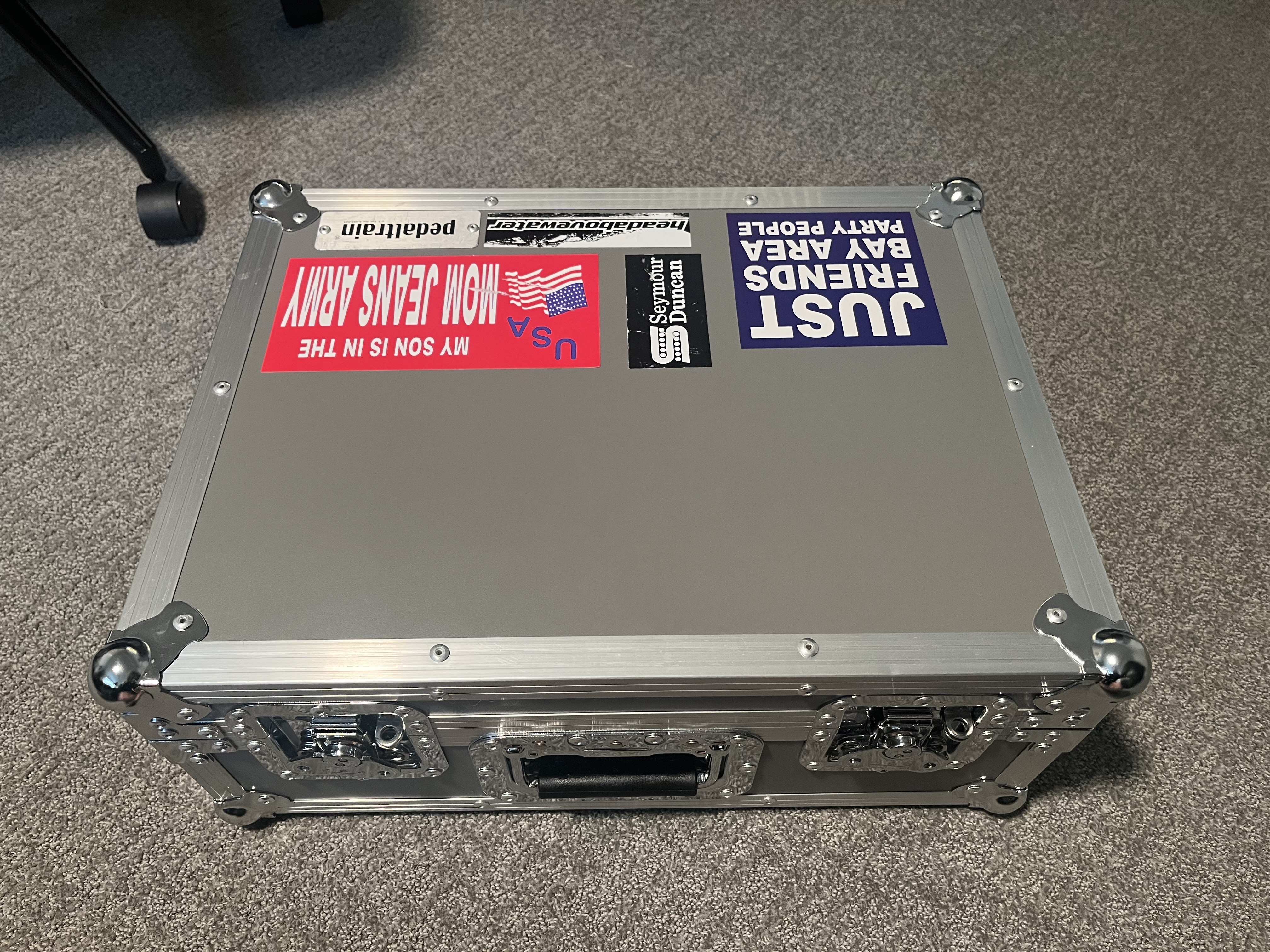
This is a pedalboard I designed and built for a friend who plays guitar in a post-hardcore band. They had specific needs that were not being met with their current rig that they asked me to solve with an overhaul of their live rig.
Requirements:
-Ampless touring setup
-Option to use with or without a cabinet on stage -Produce the variety of sounds / tones that are required for their live set, including 3 channels of drive tones, ambience/feedback between songs, and specific modulation on a few tracks
-Low noise / unwanted feedback while allowing for plenty of delay self-oscillation / and intentional feedback.
-Variety on top of all of this for recording
-IEC power cables for easy replaceability
-As small as possible footprint
-Hard case for touring and protecting valuable / vintage equipment
-Repair of their vintage Phase 90
Signal Flow:
Polytune 3 > 20/20 boost/overdrive > Line 6 DL4 > Vintage MXR Phase 90 > Sketchy Sounds Lost Soul > Universal Audio Anti 1992 > Vintage Electro-Harmonix Holy Grail reverb > Seymour Duncan Powerstage 200
This rig build met and exceeded the requirements, and has an incredible range of tones. For a touring musician, an ampless rig is invaluable, reducing the amount of gear to load, and protecting expensive amplifiers from the rigor of touring. First off, and maybe most importantly, this board is powered by a truetone CS12 isolated power supply. This power supply was chosen because it runs off of an IEC power cable, and meets / exceeds the requirements for number of outputs and amperage for each pedal. The pedals sit on top of a PedalTrain Classic JR board. Careful planning ensured this was the smallest possible board that allowed for the best possible layout of the pedals, with room for the power supply on the underside. Ampless rigs need to be built to emulate three distinct parts of a traditional amplifier, the preamp, poweramp, and cabinet. For this build, the preamp tone is handled by the UA Anti 1992, modeling an Peavey 5150. The built in noise gate on the Anti is also invaluable for taming high gain guitar tones and keeping noise controllable. The power amp duties are handled by the Seymour Duncan Powerstage 200, adding both accurate poweramp tone and the option to power up to two on stage cabinets. In the event a cabinet is not needed/wanted, cabinet simulation can be provided by either the Anti or the Powerstage, with DI out to FOH from the powerstage. In front of the Anti, is what would be on a traditional pedalboard. Gain staging here is handled by the 20/20 overdrive. The 20/20 is a dual overdrive/boost pedal allowing for two different “channels” of gain. With a high gain amp like the 5150, running a light overdrive in front acts as a thickening agent, and the boost section of the 20/20 is great for driving the amp into dirtier territory as well. Modulation is handled by the DL4, Phase 90, and the Holy Grail in the pseudo fx loop, between the preamp and power amp. The DL4 is doing most of the heavy lifting as far as modulation, with a number of modulation effects on the different footswitches. The Holy Grail and Phase 90 exist to do their individual specialties on top of what is provided with the DL4. The Lost Soul does a unique glitch / slapback thing with added fuzz and pitch modulation.
Requirements:
-Ampless touring setup
-Option to use with or without a cabinet on stage -Produce the variety of sounds / tones that are required for their live set, including 3 channels of drive tones, ambience/feedback between songs, and specific modulation on a few tracks
-Low noise / unwanted feedback while allowing for plenty of delay self-oscillation / and intentional feedback.
-Variety on top of all of this for recording
-IEC power cables for easy replaceability
-As small as possible footprint
-Hard case for touring and protecting valuable / vintage equipment
-Repair of their vintage Phase 90
Signal Flow:
Polytune 3 > 20/20 boost/overdrive > Line 6 DL4 > Vintage MXR Phase 90 > Sketchy Sounds Lost Soul > Universal Audio Anti 1992 > Vintage Electro-Harmonix Holy Grail reverb > Seymour Duncan Powerstage 200
This rig build met and exceeded the requirements, and has an incredible range of tones. For a touring musician, an ampless rig is invaluable, reducing the amount of gear to load, and protecting expensive amplifiers from the rigor of touring. First off, and maybe most importantly, this board is powered by a truetone CS12 isolated power supply. This power supply was chosen because it runs off of an IEC power cable, and meets / exceeds the requirements for number of outputs and amperage for each pedal. The pedals sit on top of a PedalTrain Classic JR board. Careful planning ensured this was the smallest possible board that allowed for the best possible layout of the pedals, with room for the power supply on the underside. Ampless rigs need to be built to emulate three distinct parts of a traditional amplifier, the preamp, poweramp, and cabinet. For this build, the preamp tone is handled by the UA Anti 1992, modeling an Peavey 5150. The built in noise gate on the Anti is also invaluable for taming high gain guitar tones and keeping noise controllable. The power amp duties are handled by the Seymour Duncan Powerstage 200, adding both accurate poweramp tone and the option to power up to two on stage cabinets. In the event a cabinet is not needed/wanted, cabinet simulation can be provided by either the Anti or the Powerstage, with DI out to FOH from the powerstage. In front of the Anti, is what would be on a traditional pedalboard. Gain staging here is handled by the 20/20 overdrive. The 20/20 is a dual overdrive/boost pedal allowing for two different “channels” of gain. With a high gain amp like the 5150, running a light overdrive in front acts as a thickening agent, and the boost section of the 20/20 is great for driving the amp into dirtier territory as well. Modulation is handled by the DL4, Phase 90, and the Holy Grail in the pseudo fx loop, between the preamp and power amp. The DL4 is doing most of the heavy lifting as far as modulation, with a number of modulation effects on the different footswitches. The Holy Grail and Phase 90 exist to do their individual specialties on top of what is provided with the DL4. The Lost Soul does a unique glitch / slapback thing with added fuzz and pitch modulation.


 →
→